|
|

No Photography撮影禁止 - The sign reads "Satsuei kinshi." "Satsuei" means to take photos, and "kinshi" means "prohibited." The "No photo" symbol also makes it clear.
On Japanese warning signs, the three most common words you will see are "kinshi" (禁止), "kiken" (危険), and "chui" (or "go-chui") (注意). They respectively mean "prohibited," "danger," and "beware of."
Place: World PC Expo in Makuhari Messe in Chiba.
|
|

No Photography撮影禁止 - Another sign that reads (top to bottom) "Satsuei kinshi." "Satsuei" means to take photos, and "kinshi" means prohibited. At this Shinto shrine, you are not allowed to photograph inside the main shrine building housing the altar.
Place: A shrine in Kyoto.
|
|

No Tripods三脚使用禁止 - The bold characters read, "Sankyaku shiyō kinshi" meaning tripod use is prohibited. The sign further explains that since tripods hinder the view of other spectators, they are not allowed except in the press photographers' box.
The kanji characters for tripod consists of "san" for three (the 3 horizontal lines make it obvious), and "kyaku" which means legs.
Place: Tsurugaoka Hachiman Shrine (during the Yabusame Festival), Kamakura, Kanagawa Pref.
|
|

No Tripods and Monopods, unless...三脚 一脚 - This sign says "Sankyaku, ikkyaku go-shiyō no kata wa, kyokasho (2,000 yen) ga hitsuyō desu." Since you learned the characters for "tripod" in the preceding image, you should also know the characters for monopod, called "ikkyaku," literally "one leg."
This sign is a warning and a money-making scheme. It says that you cannot use a tripod or monopod in this garden unless you pay 2,000 yen to obtain a permission slip.
Place: Heian Shrine Garden, Kyoto.
|
|
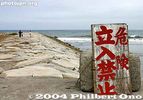
Danger, Keep Out危険 立入禁止 - The kanji characters on the right say "kiken" meaning danger. The big characters on the left say "tachi-iri kinshi" meaning "entry prohibited." Remember the word "kiken" (危険). It is one of the three most common words on warning signs in Japan. Another one is "kinshi" (禁止). If you see it, be aware that something is prohibited.
Place: Ohara beach, Chiba.
|
|

Do not Enter立入禁止 - Another "entry prohibited" sign or "tachi-iri kinshi" in red kanji characters. On the right, the characters read, "kankei-sha igai" meaning "unauthorized persons."
Place: Lake Biwa at Otsu, Shiga Pref.
|
|
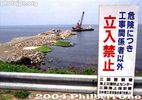
Do Not EnterThis sign is similar to the preceding one. The middle column of characters has the word "kōji" (工事) which means construction. So the sign means, "Danger: No entry except for authorized construction workers."
Place: Mikuni-cho, Fukui Pref.
|
|
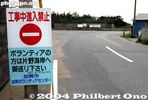
Under Construction - Do Not Enter工事中 - Another variation of "Do not Enter." The red characters read "Kōji-chū shinnyū kinshi" meaning no entry during construction operations. The "No entry" traffic symbol is also a tell-tale sign. You usually see this symbol at the entrance of a one-way road (if you face the wrong direction).
|
|
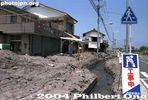
Under Construction工事中 - The sign reads "Kōji-chū" meaning "under construction." You see this often at Japanese Web sites as well.
Place: Near Mt. Fugendake, Nagasaki Pref. (Note that the year stated in the image indicates the year the photo was first published, not the year when the picture was taken.)
|
|

Go Slow徐行 - The sign on the right says "Jokō" meaning go slow (when boarding or disembarking from the ferry). You may see this at construction sites as well.
Place: Onomichi, Hiroshima Pref.
|
|

Danger! Do not Jump in River危険!川へ飛び込まないでください。- The red characters read "Kiken!" (Danger!), and the black characters say "Kawa e tobi komanaide kudasai." "Kawa" is river, "tobi komi" is to jump or dive in.
This at the famous Dotonbori canal in central Osaka where it is a popular place for fanatical baseball fans to jump in whenever the local baseball team (Hanshin Tigers) wins big. The river is quite polluted and littered with trash (though recently cleaned up by the city). During the Soccer World Cup in 2002, several hundred people jumped in the water when the Japan team won a crucial game.
Place: Dotonbori, Osaka.
|
|

No Swimming遊泳禁止 - By now you must be getting sick of seeing this word "kinshi." Well, it's certainly not a pleasant word since it limits your freedom. But it also serves to keep you safe. The kanji in red reads "yūei kinshi" meaning "swimming (and playing in the water) prohibited." Below in black reads, "Koko wa suieijō dewa arimasen." This is not a place for swimming.
Place: Lake Biwa at Otsu, Shiga Pref.
|
|
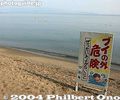
Do not Go Beyond the Buoysブイの外 危険 - It reads "Bui no soto kiken" which means "Dangerous to go beyond the buoy." The buoys in this case are the brightly-colored floating balls that mark the outer boundary of the safe swimming area. The water is usually too deep or the waves are too dangerous beyond this boundary. Almost all swimming beaches in Japan have some kind of outer boundary.
Place: Northern Lake Biwa, Shiga Pref.
|
|
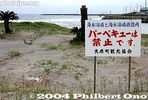
No BBQバーベキューは禁止です - The characters in red say, "barbecue wa kinshi desu." Having a barbecue is prohibited.
Place: Ohara beach, Chiba Pref.
|
|

Take Off Your Shoes土足厳禁 - It says "Dosoku genkin" or footware prohibited. "Dosoku" literally means dirty feet, and "genkin" is like "kinshi," meaning prohibited. So we have to take off our footwear before going up the stairs to see the second floor of this museum.
In most places, it will be obvious that you have to take off your shoes before entering the castle, museum, temple, etc. At the entrance hall, you will see a shelf to store shoes and indoor slippers lined up on the floor.
Place: Azuchi, Shiga Pref.
|
|
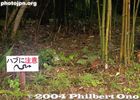
Beware of Habu Snakesハブに注意 - "Habu ni chūi." Finally we see the third most common word on warning signs: Chui, meaning "beware of" or "watch out for." Habu is a species of poisonous snake common in Okinawa where this picture was taken.
Place: Okinawa
|
|
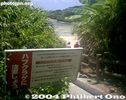
Beware of Jellyfishハブクラゲに注意しよう! - "Habu kurage ni chūi shiyō." Beware of jellyfish. In Okinawa, "habu kurage" (Chiropsalmus quadrigatus) is a type of poisonous jellyfish whose venomous sting can cause death.
Place: Taketomi island, Okinawa.
|
|

Beware of Wild Monkeys野生の猿にご注意 - "Yasei no saru ni go-chūi." "Yasei" means wild, and "saru" is monkey. Japan has a substantial population of wild monkeys which can be very aggressive in foraging for food, especially at tourist spots. They often steal food (sweets, etc.) from tourist shops and commonly grab any paper or plastic bag that you are carrying. If you see wild monkeys, you should not feed them nor carry any bags with your hands.
The sign also says "We cannot be responsible for any accidents caused by wild monkeys."
Place: Mt. Hiei Driveway, Kyoto.
|
|
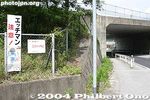
Beware of Flashers!エッチマン注意! - Besides watching out for poisonous snakes, jellyfish, and wild monkeys as you saw in the previous images, there's one last wild animal to watch out for: the flasher. Apparently, this country neighborhood has had a flasher (a person who shows his genitals) so often that they put up this sign to warn female passers by.
The sign reads "H man chūi!" "H" is for "hentai" meaning pervert. "Man" is man, and you know what "chūi" means.
Place: Country road, northern Shiga Pref.
|
|
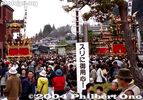
Watch Out for Pickpockets!スリに御用心 - Another human animal to watch out for. "Suri ni go-yōjin!" means watch out for pickpockets! "Suri" means pickpocket, and "go-yōjin" is like "chūi."
Place: Takayama Festival, Gifu Pref.
|
|
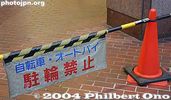
No Bicycle/Motorcycle Parking駐輪禁止 - "Chūrin kinshi" in red characters mean two-wheeled vehicles cannot park here. In blue characters, it says "jitensha" (bicycles) and "ōtobai" (motorcycles and motor scooters).
Place: Street corner near a train station in Tokyo.
|
|

No Smoking on Street路上喫煙はやめましょう - This is "Rojō kitsuen wa yamemashō." It means please don't smoke while walking on the street.
Place: Street corner near a train station in Tokyo.
|
|
|
|
|
|